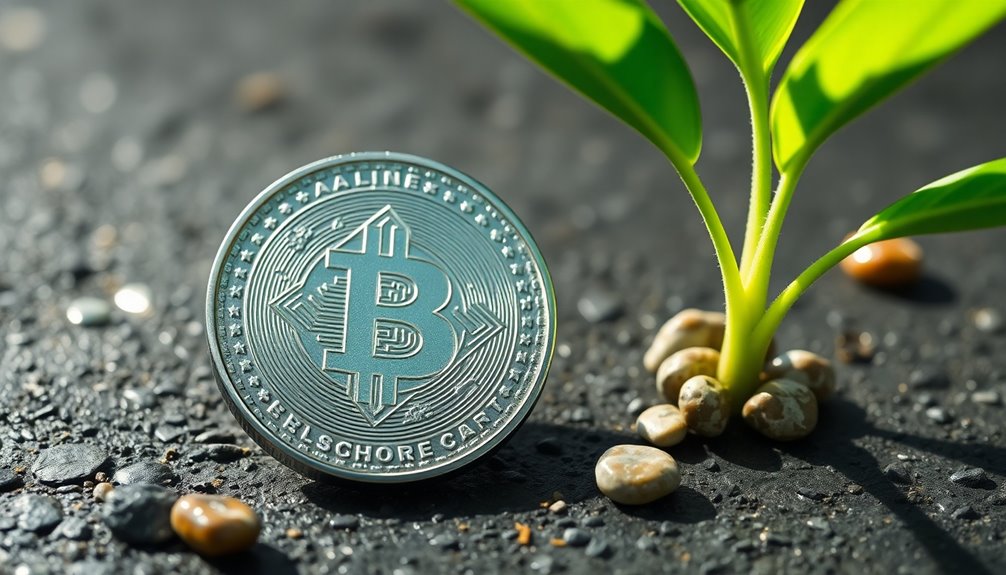When exploring the most stable cryptocurrencies, stablecoins like Tether (USDT) and USD Coin (USDC) stand out. They mitigate volatility by pegging to fiat currencies, making them essential for cross-border transactions. USDT boasts a significant market cap, while USDC is known for its reliable reserves and regular audits. These coins offer high liquidity, but keep in mind the regulatory scrutiny surrounding their transparency and reserve management. You might also want to consider decentralized options like Dai (DAI) or innovative newcomers like First Digital USD (FDUSD). With so many choices, there's much to uncover on your journey into stability.
Key Takeaways
- Stablecoins like Tether (USDT) and USD Coin (USDC) are designed to maintain price stability by pegging to fiat currencies.
- Fiat-backed stablecoins maintain reserves equivalent to issued coins, providing security against market volatility.
- Regular audits and transparency in reserve management, as seen with USDC, enhance investor confidence in stablecoins.
- Algorithmic stablecoins, while innovative, pose higher market risks due to their reliance on supply control through smart contracts.
- The regulatory environment is evolving, with frameworks emerging to ensure compliance and stability in the stablecoin market.
Stablecoin Fundamentals Explained

While you may already know that cryptocurrencies can be volatile, stablecoins offer a solution by maintaining a consistent value, often pegged to fiat currencies like the U.S. dollar.
The most popular types are fiat-backed stablecoins, such as Tether (USDT) and USD Coin (USDC), which are backed by real-world assets. Tether leads the market with a staggering market capitalization of about $82.44 billion, while USD Coin follows with $51.35 billion.
These stablecoins are crucial for cross-border payments and decentralized finance (DeFi) applications, accounting for over 90% of all on-chain transactions.
However, be aware of the risks associated, including counterparty risk, regulatory scrutiny, and transparency issues regarding the reserves backing their value.
Stablecoins: a Foundational Overview

Stablecoins serve as a cornerstone in the cryptocurrency landscape, providing a means to mitigate the volatility typically associated with digital assets. Designed to maintain value, these cryptocurrencies are often pegged to fiat currencies like the U.S. dollar.
Tether (USDT) and USD Coin (USDC) are common examples, with Tether boasting a market cap of approximately $82.44 billion. They maintain their value through reserves, which can include fiat currencies or other assets, ensuring liquidity and security for investors.
In the cryptocurrency ecosystem, stablecoins account for over 90% of all on-chain transactions, making them vital for cross-border payments and daily transactions.
However, increasing regulatory scrutiny highlights the need for transparency and adequate reserves to uphold consumer trust and financial stability. Furthermore, the rise of AI-driven platforms in various sectors is beginning to influence the development and integration of stablecoins.
Mechanisms of Price Stability

To maintain price stability, stablecoins utilize various mechanisms, primarily through pegging to fiat currencies or commodities.
Fiat-backed stablecoins, like Tether (USDT) and USD Coin (USDC), hold reserves of real-world assets, ensuring that for every coin issued, an equivalent amount of fiat currency is kept in reserve. This practice provides security against volatility and illustrates the importance of trustworthy backing, especially given Tether's market cap exceeding $82 billion.
Transparency in reserve management is crucial; USD Coin undergoes regular audits to confirm sufficient reserves.
On the other hand, algorithmic stablecoins use smart contracts to control supply, though they can be riskier due to their dependence on market dynamics and financial institutions.
Pros and Cons Summary

Although stablecoins offer a range of benefits, they also come with notable drawbacks. Tether (USDT) and USD Coin (USDC) are popular for their high liquidity and significant market caps, but they face regulatory scrutiny and transparency concerns regarding their reserves.
While USDC is backed by cash and U.S. Treasuries, ensuring reliability, Tether's backing has raised questions among users.
On the other hand, decentralized stablecoins like Dai (DAI) provide unique governance models, but their reliance on over-collateralization can complicate liquidity.
Binance USD (BUSD) presents a fiat-pegged option regulated by the NYDFS, yet it, too, must navigate the complexities of regulatory compliance.
Weighing these pros and cons is essential for anyone considering stablecoin investments.
Stablecoin Value Stability Methods

While many investors seek stability in their cryptocurrency holdings, stablecoins achieve this primarily through various pegging mechanisms.
These digital assets are often pegged 1:1 to fiat currencies like the U.S. dollar, which helps minimize price volatility.
Fiat-backed stablecoins, such as Tether (USDT) and USD Coin (USDC), hold reserves of cash or equivalent assets in regulated institutions, ensuring their value stability even during economic instability.
Tether, with a market cap of about $82.44 billion, and USD Coin, at around $51.35 billion, demonstrate significant liquidity.
Transparency, reinforced by regular audits for USDC, is vital for maintaining trust, as it provides assurance regarding the reserves backing these stablecoins against market fluctuations.
Regulatory Scrutiny and Compliance

As regulatory scrutiny of stablecoins intensifies, authorities worldwide are honing in on compliance with anti-money laundering (AML) and counter-terrorism financing (CFT) standards. This focus is vital for consumer protection and financial stability.
The European Union's Markets in Crypto-Assets (MiCA) regulation aims to create a unified framework, enhancing oversight of asset-referenced tokens (ARTs) and e-money tokens (EMTs).
In Singapore, the Monetary Authority of Singapore has finalized regulations for single-currency stablecoins, emphasizing adherence to local financial laws.
In the U.S., ongoing debates about reserve requirements and operational transparency are shaping the future of stablecoin legislation.
Japan's emerging framework allows banks to issue fiat-backed stablecoins under strict reserve requirements, promoting innovation while ensuring market integrity and confidence in cross-border transactions.
Emerging Stablecoin Innovations

With the rapid evolution of the cryptocurrency landscape, new stablecoin innovations like First Digital USD (FDUSD) and Ethena USDe (USDe) are reshaping how you engage with digital assets.
Emerging stablecoins are gaining traction for features like FDUSD's transparent reserve management and regulatory compliance under Hong Kong's Trust Ordinance.
Meanwhile, Ethena USDe focuses on scalability and censorship resistance, democratizing investment opportunities within decentralized finance (DeFi).
Algorithmic stablecoins are also evolving, introducing mechanisms for stability, though they carry higher risks.
The innovation in stablecoin technology, including programmability and integration with traditional financial systems, enhances their utility in everyday transactions.
As regulatory advancements unfold, they'll continue to influence the design and operational frameworks of these emerging stablecoins.
Diversify Across Multiple Stablecoins

Emerging stablecoin innovations present an opportunity for you to enhance your investment strategy by diversifying across multiple stablecoins. By investing in options like Tether (USDT) and USD Coin (USDC), you can take advantage of their unique strengths.
Tether boasts a market cap of around $82.44 billion, offering high liquidity, while USD Coin emphasizes regulatory compliance and is backed by cash and U.S. Treasuries, with a market cap of approximately $51.35 billion.
Additionally, incorporating decentralized options like Dai (DAI), which is collateralized by various cryptocurrencies, can further your diversification. Engaging with stablecoins in decentralized finance (DeFi) allows you to earn passive income through staking and yield farming, maximizing your investment potential while managing risk effectively.
Frequently Asked Questions
What Is the Most Stable Crypto?
When you're looking for the most stable crypto, Tether (USDT) often tops the list.
It's widely used and backed by reserves like U.S. Treasury bills, providing a sense of security.
Another strong contender is USD Coin (USDC), known for its transparency and regular audits.
These stablecoins are designed to minimize volatility, making them reliable options for transactions and investments.
Which Crypto Has 1000X Potential?
If you're looking for a cryptocurrency with 1000x potential, focus on innovative projects with strong use cases and active communities.
Smaller market cap altcoins often present high-risk, high-reward opportunities. Thoroughly research each project's team, partnerships, and roadmap to gauge its growth potential.
Keep an eye on market trends and investor sentiment; these can signal which cryptocurrencies might soar in value.
What Crypto Under $1 Will Explode?
If you're looking for a cryptocurrency under $1 that might explode, consider Dogecoin (DOGE), Shiba Inu (SHIB), or VeChain (VET). Each has a strong community and growing use cases.
Stellar (XLM) focuses on cross-border payments, offering potential growth, while Cardano (ADA) is innovating in scalability.
Ripple's XRP, despite regulatory issues, remains relevant for fast transactions.
Keep an eye on these coins; they could see significant price increases in the near future.
What Is the Most Reliable Cryptocurrency?
When you're looking for the most reliable cryptocurrency, Tether (USDT) often stands out due to its large market cap and 1:1 peg to the U.S. dollar.
You might also consider USD Coin (USDC) for its transparency and backing by cash and U.S. Treasuries.
Binance USD (BUSD) offers regulatory compliance, while Dai (DAI) uses over-collateralization for stability.
Each option provides a degree of reliability, depending on your investment strategy and risk tolerance.
Conclusion
In exploring the most stable cryptocurrencies, you've discovered the crucial role stablecoins play in the crypto ecosystem. Their mechanisms for price stability, along with the pros and cons, help you make informed decisions. As regulatory scrutiny increases, staying updated on emerging innovations is essential. By diversifying across multiple stablecoins, you can better manage risk and harness the benefits these digital assets offer. Embrace the stability they provide to enhance your overall investment strategy.









